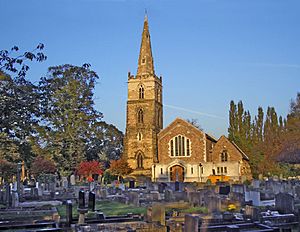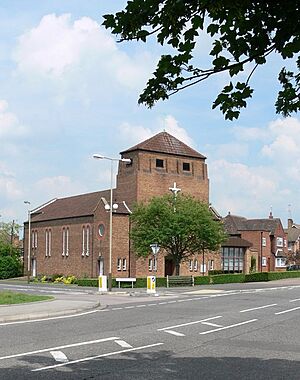Knighton, Leicester facts for kids
Quick facts for kids Knighton |
|
|---|---|
 St. Mary Magdalen Church and churchyard cemetery, Knighton, Leicester |
|
| Population | 16,805 (2011 census) |
| Unitary authority | |
| Shire county | |
| Region | |
| Country | England |
| Sovereign state | United Kingdom |
| Post town | LEICESTER |
| Postcode district | LE2 |
| Dialling code | 0116 |
| EU Parliament | East Midlands |
| UK Parliament |
|
Knighton is a neighborhood in Leicester, England. It's a residential area located south of the city center. You can find it between Clarendon Park to the north and Stoneygate to the east. To the south are Oadby and Wigston, and to the west is the Saffron Lane estate.
Knighton was once a separate village, a few miles from Leicester. During the Victorian era, it grew and connected to the city. This happened because many new homes were needed for people working in factories. Even today, you can still see some of the village's original buildings. These include Oram Cottage and the Church of St. Mary Magdalen. The old village center is now a special conservation area.
Contents
Who Lives in Knighton?
In 2011, about 16,805 people lived in the Knighton area. The population of the ancient parish of Knighton was 383 in 1831. It grew to 6,075 by 1891 as Leicester expanded. Knighton itself saw a lot of building in the 1930s and 1940s. Many red-brick semi-detached houses were built then. The area continued to grow in the mid-20th century. New housing estates like West Knighton and South Knighton were added. These areas have a mix of homes from the post-war time.
A Look Back at Knighton's History
Knighton is mentioned in the Domesday Book of 1086. It was called Cnihetone back then. The book describes it as a fairly large village with 24 households and lots of farmland. All of it was owned by the Bishop of Lincoln. For a long time, Knighton was a separate civil parish between Leicester and Wigston Magna. It kept its own identity until the late 1800s.
Knighton's church, St Mary Magdelene, was connected to St Margaret's Church, Leicester. Both churches were owned by the Bishop of Lincoln. St Margaret's was a special church of Lincoln Cathedral. This gave it more freedom than other churches in Leicester. Knighton Church dates back to at least the 1200s. It had a curate, but not its own vicar, until 1878. That's when it became a separate church parish.
In medieval times, Knighton's economy was based on farming. The village had four large open fields. These fields were divided into narrow strips. Each year, different families in the village would be given strips to farm. In 1756, these fields were officially divided up permanently. This was called the Enclosure award. The land was shared among 14 families who had rights to it. The Craddock family, who were the Lords of the Manor, received almost 700 acres.
How Stoneygate Grew
Knighton remained a farming area into the 1800s. Meanwhile, Leicester and Wigston became centers for making knitted goods. The first signs of Leicester's growth appeared in Stoneygate. This area was part of Knighton parish. Suburban development began in the 1770s and 1780s. A large house called Stoneygate House was built. Later, a farmhouse was turned into a fancy home called The Stoney Gate.
By the 1840s, there were 10 houses along London Road. Wealthy business people and factory owners from Leicester lived there. This trend of rich people building large homes continued until 1863. By then, there were 32 such mansions. After 1865, new side roads were opened. Builders started to develop these areas quickly. This led to faster growth and more homes being built.
The Rise of Clarendon Park
Starting in 1875, a large area of land was sold for development. This land used to be one of Knighton's open fields. The houses built here were closer together than in Stoneygate. Many streets were laid out with rows of brick terraced homes. This area became known as Clarendon Park. This name was likely used to help sell the new homes.
By 1888, most of Clarendon Park's roads were built and filled with houses. Streets like Queen's Road and Clarendon Park Road got shops and other community places. Many large churches were quickly built in both Clarendon Park and Stoneygate. These included St John the Baptist Anglican Church (1885) and Queen's Road Primitive Methodist (1887).
Changes to the Boundaries
The historic Knighton parish covered a wide area. It stretched about 2.8 miles (4.5 km) from west to east. Knighton was once a small part of St. Margaret parish. In 1866, Knighton became its own civil parish. But it was officially joined with Leicester on March 26, 1896.
Exploring Knighton Park
Knighton Park is in the southern part of the neighborhood. It's south of the A563 Palmerston Way road. This 78-acre (31.5-hectare) park was bought by Leicester city council in the late 1930s. However, World War II delayed its opening as a public park until 1953. The different parts of the park still show how the land was divided in 1756. This was when Knighton's open fields were first enclosed for farming improvements.
Knighton Spinney is a small forest area on the north-east side of the park. It covers 2.9 hectares (7.2 acres). In 2003, it was named a Local Nature Reserve. Squire Craddock-Hartopp planted oak and ash trees here in 1840. He was worried about not having enough oak trees for shipbuilding. But ships started being made of iron, so the trees weren't needed for that. The spinney was then used for foxhunting. By 1932, the Craddocks saw its value for wildlife. They promised to protect it as a wildlife reserve forever. Now, it has many different types of trees and plants. It's a great home for spring flowers, birds, mammals, and insects.
Knighton Park first won the Green Flag Award in 2005. It has many fun things to do. These include two play areas, tennis courts, and a pitch & putt course (open seasonally). There's also a sensory garden and a heath garden. The Wash Brook runs through the park.
St Thomas More's Catholic Church
The church of St Thomas More was built for the local Catholic community. The parish was created in 1947. Architects Reynolds & Scott designed the church in 1948. They designed many churches in the Diocese of Nottingham. The church has a simple, classic style. Its wide west tower is a well-known landmark in the area.
While Leicester had other Catholic churches, St Thomas More's was the first built specifically for Knighton. Bishop Edward Ellis laid the foundation stone in 1950. The church officially opened in 1952. The original design included a dome over the altar and altar rails. These have since been removed. When these changes were made, a parish hall was built next to the church. The stained glass windows inside the church show important parts of the Roman Catholic faith. They have symbols of Christ's work and the sacraments.
Famous People from Knighton
- Henry Knighton: He wrote a history of England. It covered the time from the Norman conquest until 1396, the year he passed away.
- Sir William Lindsay Everard: He was a Member of Parliament, a brewer, and a pioneer in aviation.
- Clare Hollingworth: A journalist who was the first person to tell the world that World War II had begun.


